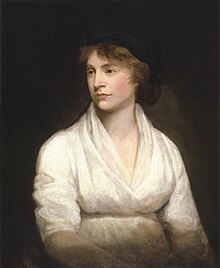List of 999 women of the Heritage Floor / Mary Wollstonecraft
This list describes the place setting for Mary Wollstonecraft on the table of Judy Chicago's art installation The Dinner Party . It is part of the list of 999 women on the Heritage Floor who are assigned to the respective place settings on the table. The names of the 999 women are on the tiles of the Heritage Floor, which is arranged below the table and belongs to the art installation.
description
The installation consists of a three-sided table, each with 13 historical or mythological personalities, thus a total of 39 people, from prehistory to the women's rights movement . These people were assigned a place setting at the table, consisting of an individually designed table runner, an individually designed plate, a goblet, knife, fork, spoon and serviette. The first page of the table is devoted to prehistory up to the Roman Empire , the second to Christianization up to the Reformation and the third from the American Revolution to the women's movement. Each place setting on the table is assigned additional personalities who have received an entry on the tiles of the Heritage Floor, which occupies the space under the table and the center of the space between the sides of the table. This list captures the personalities assigned to Mary Wollstonecraft's place setting. Your seat is on the third side of the table.
Hints
In addition to the names as they are used in German transcription or in scientific usage, the list shows the spelling chosen by Judy Chicago on the tiles.
The information on women who do not yet have an article in the German-language Wikipedia is referenced by the individual references listed under comments . If individual information in the table is not referenced via the main article, additional individual references are given at the relevant point. If there are any discrepancies between the information provided in Wikipedia articles and the descriptions of the work of art on the Brooklyn Museum website , this will also be indicated under Comments.
Place setting for Mary Wollstonecraft
Mary Wollstonecraft was born on April 27, 1759 in Spitalfields , London . She was English of Irish descent, her father was a weaver and farmer. The family often moved, which impaired their schooling due to the frequent change of school, but they were very interested in education, including equal schooling for girls. At the age of 19 she worked as a partner in Bath for a year until 1779, after which she and her sisters founded a private school in London. There she taught until 1787. She traveled to Lisbon in 1785 to help her friend with the birth of her first child. When she returned to her school in London in late 1786, she found that the school had gone bankrupt. To pay the accrued debt, Wollstonecraft worked as a governess in Ireland. After losing the job in 1787, she returned to London, where she could afford a small apartment, since her first novel, Mary , had been published.
In the autumn of 1792 she traveled to France. Thanks to a letter of recommendation from her publisher, she came into contact with other writers, politicians and other artists. She also came into contact with women's rights activists and was influenced by the British women's rights activist and historian Catherine Macaulay . Her best-known work, A vindication of the rights of woman , in which she stood up for equality , was written in France. During her first winter in France, she also met the American businessman Gilbert Imlay . Wollstonecraft and Imlay began a relationship in April 1793, from which came their daughter Fanny . To protect Wollstonecraft and her daughter, Imlay registered her as an American citizen, but did not marry Mary Wollstonecraft. Wollstonecraft spent the summer of 1794 on a three-month trip through Scandinavia. Her Letters Written During a Short Residence in Sweden, Norway, and Denmark were published in 1796. She returned to London with her daughter in 1795. The breakup made her depressed and in October she attempted suicide on Putney Bridge .
As early as 1791 she had met the proto- anarchist writer William Godwin at a reception , whom she met again in 1796 and married a year later. After her marriage she carried the double name Mary Wollstonecraft-Godwin. Their daughter Mary was born in 1797. Mary Shelly later became known as the author of the novel Frankenstein . She only survived the birth of her daughter Mary by eleven days, as the placenta that remained in the uterus led to an infection and she died of puerperal fever .
The place setting for Mary Wollstonecraft on the dinner party table was designed to illuminate the author's strong character, including her belief in women's equality. The table runner is designed using different craft techniques. There are needle points, petitpoints, embroidery, crochet work and stump work. Wollstonecraft's life is depicted in pictures with scenes from the home environment. Her tragic death is depicted on the back. The pictures with birds, flowers and apples on the front are intended to highlight the triviality of female existence in the 18th century. In contrast to the simple, domestic design of the table runner, the plate is elaborate and three-dimensional. The raised surface serves Chicago as a metaphor for Wollstonecraft's will and intelligence. The initial letter “M” on the front of the table runner is decorated with two icons, a cylinder and a glove, which represent Wollstonecraft's life's work. On her deathbed she said: “I threw down the glove. It is time to restore women to their lost dignity and to make them part of the human species. "
| Surname | Spelling on the tile | Date of birth | cultural spatial assignment | Remarks | image |
|---|---|---|---|---|---|
| Alcipe | Leonor D'Almeida | 1750 | Kingdom of Portugal , Lisbon | Noblewoman, poet and translator, founded the "Sociedade da Rosa", an anti-Napoleonic institution. |

|
| Alison Cockburn | Alison Rutherford | 1712 | Scotland | Poet, humorist and salonière who made a circle of excellent friends in Edinburgh in the 18th century , including Walter Scott , Robert Burns and David Hume . | |
| Bridget Bevan | Bridget Bevan | 1698 | Wales | Educator and benefactress. |

|
| Caroline Pichler | Karoline Pichler | 1769 | Archduchy of Austria | Writer, poet, critic and salonière . |

|
| Caroline Schelling | Caroline Schlegel | 1763 | Goettingen | Writer and translator. She belonged to the group of Göttingen professors' daughters known as university girls and is considered the muse of various romantic poets and thinkers . |
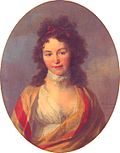
|
| Celia Fiennes | Celia Fiennes | 1662 | England | Travel writer who became the first woman to travel to all English counties . | |
| Charlotte Corday | Charlotte Corday | 1786 | First French Republic | Assassin of the French revolutionary Jean Paul Marat . At her trial, Corday revealed her idealistic ambition and allegedly proclaimed, "I killed a man to save 100,000." |

|
| Delarivier Manley | Mary Manley | around 1663 | England | Author, gained international fame through extensive production of romaneses and journalistic articles. | |
| Elizabeth Carter | Elizabeth Carter | 1717 | England | English poet, classicist, writer, translator and member of the Bluestocking Circle. |

|
| Elizabeth Hamilton | Elizabeth Hamilton | 1756 | Scotland | Essayist, poet, satirist and novelist. |

|
| Elizabeth Montagu | Elizabeth Montagu | 1718 | England | Salon lady , writer and patron , the " bluestocking co-founded" movement in England in the 18th century (Blue Stockings Society). |
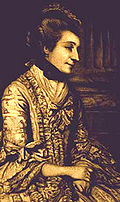
|
| Elizabeth Vesey | Elizabeth Vesey | 1715 | Ireland | Wealthy intellectuals associated with the Bluestockings group, a social and educational circle for women. |

|
| Françoise d'Aubigné, marquise de Maintenon | Francoise de Maintenon | 1635 | France | Mistress and in a morganatic marriage the second wife of Louis XIV of France. |

|
| Germaine de Staël | Germaine de Staël | 1766 | France , Switzerland | Forerunner of the sociology of literature and comparative literature . Her most widely read work was Über Deutschland . |

|
| Hannah More | Hannah More | 1745 | England | Religious writer and philanthropist, active as a poet and playwright among Johnson, Reynolds and Garrick. |
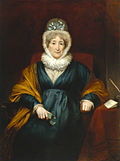
|
| Hester Stanhope | Hester Stanhope | 1776 | England | Adventurer. She ruled over a local "empire" in the Druze Mountains of Lebanon . |

|
| Ida Pfeiffer | Ida Pfieffer | 1797 | Archduchy of Austria | World traveler and travel writer who was the first European woman to cross the interior of the island of Borneo . |
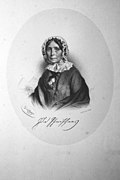
|
| Isabella Bishop | Isabella Bishop | 1831 | England | Researcher, naturalist, photographer and writer. She founded the John Bishop Memorial Hospital with Fanny Jane Butler and was the first woman to be elected a Fellow of the Royal Geographical Society . |
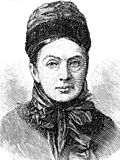
|
| Jeanne Louise Henriette Campan | Jeanne Campan | 1752 | France | Fluent in French, English and Italian, she became the reader of Louis XV's three daughters . A few years later she became Marie Antoinette's closest confidante when she came to Versailles . |

|
| Ekaterina Romanovna Vorontsova-Dashkova | Yekaterina Dashkova | 1743 | Russian Empire | Close confidante of the Russian Empress Catherine the Great and an important figure of the Enlightenment in Russia, among other things as head of the Russian Academy of Sciences . |

|
| Josefa Amar y Borbon | Josefa Amar | 1749 | Kingdom of Spain | Writer who belonged to a group that was concerned about the decadence of conditions in Spain and wanted to correct it through education. | |
| Madame de Pompadour | Jeanne de Pompodour | 1721 | France | Mistress of the French King Louis XV. |
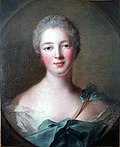
|
| Madame Roland | Jeanne Manon Roland | 1754 | France | Political figure in the French Revolution , who ran a salon in Paris and, at the side of her husband, had a major influence on Girondist politics . |

|
| Marie-Madeleine de La Fayette | Marie de Lafayette | 1634 | France | Noblewoman and writer, her novel La Princesse de Clèves is considered France's first historical novel and one of the first in European literary history. |

|
| Marie Tussaud | Marie Tussaud | 1761 | England , France | Wax artist and founder of the Madame Tussauds museum in London named after her . |
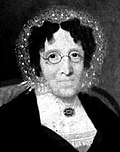
|
| Mary Ann Radcliffe | Mary Radcliffe | around 1746 | England | Important figure in the early women's movement. | |
| Mary Boyle, Countess of Cork and Orrery | Mary Monckton | 1746 | England | Run a literary salon in London. |
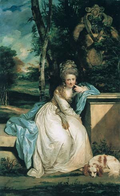
|
| Mary Hays | Mary Hays | 1759 | England | Self-taught who published essays, poems, novels and some works on famous or infamous women, early feminist. | |
| Mary Shelley | Mary Shelley | 1797 | London | Writer , author of Frankenstein or The Modern Prometheus , several novels, essays, short stories, plays, poems, reviews, biographies and travel stories. Wife of Percy Bysshe Shelley , daughter of William Godwin and Mary Wollstonecraft . |
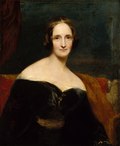
|
| Mary Wortley Montagu | Mary Wortley Montagu | 1689 | England , Turkey | Writer . |

|
| Olympe de Gouges | Olympe de Gouges | 1748 | France | Revolutionary , women's rights activist , writer and playwright in the Age of Enlightenment . She is the author of the Declaration of the Rights of Women and Citizens of 1791. |
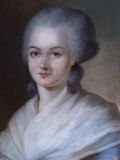
|
| Rahel Varnhagen from Ense | Rachel Varnhagen | 1771 | Kingdom of Prussia | Writer and Salonnière of Jewish descent. Rahel Varnhagen belonged to the romantic epoch and at the same time represented positions of the European Enlightenment . She advocated Jewish emancipation and the emancipation of women. |
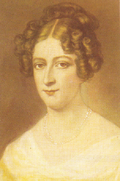
|
| Suzanne Curchod | Suzanne Necker | 1737 | Switzerland | Writer and important Parisian salonier of the Enlightenment . |

|
| Théroigne de Méricourt | Théroigne de Mericourt | 1762 | France | Also called the “Amazon of the French Revolution ” because she advocated arming women. As an eloquent speaker, she made fiery speeches in clubs, in front of the National Assembly and in the streets. In 1793 she was attacked by angry sans-culottes , badly mistreated and injured in the head. |
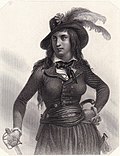
|
- Individual evidence
- ↑ Brooklyn Museum: Mary Wollstonecraft. In: brooklynmuseum.org. Retrieved October 31, 2019 .
- ^ Brooklyn Museum: Alison Rutherford. In: brooklynmuseum.org. Retrieved September 22, 2019 .
- ↑ Brooklyn Museum: Bridget Bevan. In: brooklynmuseum.org. Retrieved October 29, 2019 .
- ^ Brooklyn Museum: Elizabeth Vesey. In: brooklynmuseum.org. Retrieved October 29, 2019 .
- ^ Brooklyn Museum: Hannah More. In: brooklynmuseum.org. Retrieved October 29, 2019 .
- ^ Brooklyn Museum: Josefa Amar. In: brooklynmuseum.org. Retrieved October 29, 2019 .
- ^ Brooklyn Museum: Mary Radcliffe. In: brooklynmuseum.org. Retrieved October 29, 2019 .
- ^ Brooklyn Museum: Mary Monckton. In: brooklynmuseum.org. Retrieved October 29, 2019 .
- ^ Brooklyn Museum: Mary Hays. In: brooklynmuseum.org. Retrieved October 29, 2019 .
Web links
- Brooklyn Museum, Mary Wollstonecraft
- The Dinner Party on the website of Through the Flower , Judy Chicago's non-profit organization
